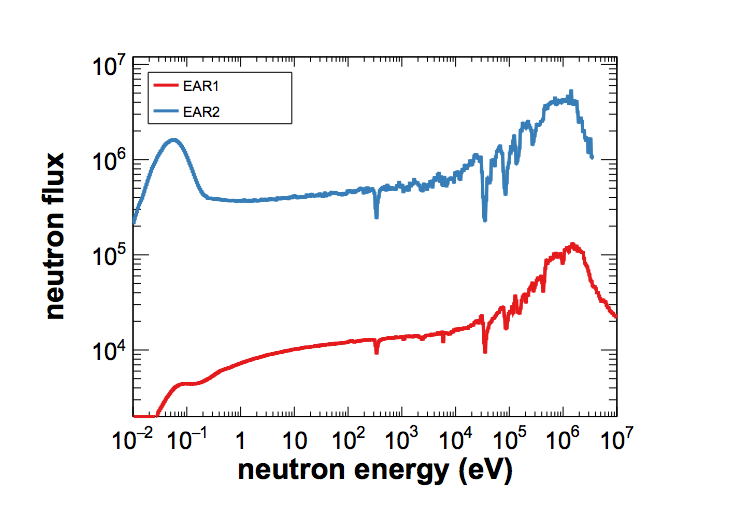n_TOF one year after - First results
Since the termination of the construction of the new second experimental area EAR2 [1,2] of n_TOF in July 2014 [3], the facility has been successfully taking data both in the existing experimental area EAR1 and in the new EAR2. The neutron beams in both areas are produced simultaneously by means of a 60 cm long by 40 cm diameter cylindrical lead spallation target on which the PS beam impinges with presently about 8x1012 protons per bunch. The pulsed character of the proton beam, and subsequently the neutron beams, allows determining the neutron kinetic energy using the time-of-flight method with neutron flight lengths of 185 m (EAR1) and 20 m (EAR2).

Figure 1: experimental setup inside EAR2. The neutron beam is directed vertically. A number of 4 C6D6-based gamma-ray detectors are viewing a sample placed in the neutron beam by means of a carbon fiber sample exchanger.
Neutron-induced reaction cross sections as measured at n_TOF play an important role in a wide variety of research fields, ranging from stellar nucleosynthesis, the investigation of nuclear level density studies, to applications of nuclear technology, including the transmutation of nuclear waste, accelerator driven systems and nuclear fuel cycle investigations.
During the long shutdown 2012-14 a new data acquisition system based on 175 MSample digitizers with 1 ns of time-, and 12 bit amplitude resolution, was developed and has been used since. In addition to the higher-amplitude resolution, which was 8 bits previously, the large on-board memory allows now to expand the exploitable time-of-flight range down to thermal neutron energies also for EAR1.
On the detector side, newly designed C6D6-based gamma-ray detectors and new neutron flux detectors based on silicon detectors and MicroMegas detectors were used in beam.
An XY-MircoMegas detector with dedicated electronics was developed to measure the neutron beam profile. The performance of several other detectors and electronics were tested in the neutron environment of EAR1 and EAR2, including HPGe detectors and silicon strip detectors.
In 2014 a period of re-commissioning started in EAR1 together with a longer programme for the commissioning of the new site EAR2. In EAR1 two neutron-capture cross-section measurements were performed, one of the isotope 73Ge and one of the radioactive isotope 171Tm. At the same time in EAR2 a first part of the commissioning was completed and a first real measurement was performed of the fission cross section of 240Pu. Several years ago the feasibility of a measurement of this highly radioactive isotope in EAR1 was tested but the high alpha activity was degrading the used fission detectors over time. In EAR2, with the much higher neutron rate resulting in a more favorable signal to noise ratio, in about 1 month enough statistics could be acquired in order complete the full measurement.
In 2015 a series of experiments have been performed in EAR1. Up to now, neutron capture measurements on the stable isotopes 70Ge and 74Ge were performed, as well as the neutron capture cross section of 204Tl. The neutron capture measurement on 242Pu has just started and the year will be completed with a 16O(n,a) measurement and a 237Np(n,f) experiment.
In EAR2, after the fission measurement in 2014, the commissioning continued, now focused on neutron capture measurements. A number of physics measurements were performed as well: two capture experiments on the radioactive targets 171Tm and 147Pm, and the (n,a) cross section on 33S. The measurement of the very low cross-section of 33S(n,a) takes full advantage of the very high neutron flux in EAR2. At present the very low (n,a) cross-section of the highly radioactive isotope 7Be is measured. For the remainder of 2015 a test of using the neutron beam for imaging purposes, and a first measurement with the fission gamma-ray detector STEFF are on the programme in EAR2.

Figure 2: The number of neutrons per equidistant logarithmic energy bin (dn/dlnE) per 7e12 protons on target, as seen at the sample position at nominal distances of 185 m (EAR1) and 20 m (EAR2). The shown fluxes are the preliminary results of several measurements and simulations.
We have exploited the key features of the n_TOF facility both in EAR1 and EAR2: a large energy range, high neutron-energy resolution, and a very high instantaneous neutron flux for a number of isotopes with low cross-sections or with a high radioactivity. The preparation and characterization of such targets suitable for neutron cross-section measurements is an increasingly complicated task feasible only in highly specialized labs of institutes, of which some are part of the n_TOF collaboration. Analyses of the taken data are in progress and proposals for future measurements are in preparation.
References
[1] E. Chiaveri et al., Proposal for n_TOF Experimental Area 2, CERN-INTC-2011-032
[2] C. Weiß et al, Nucl. Instr. Meth. A 799 (2015) 90
[3] PH letter n_TOF 2014
